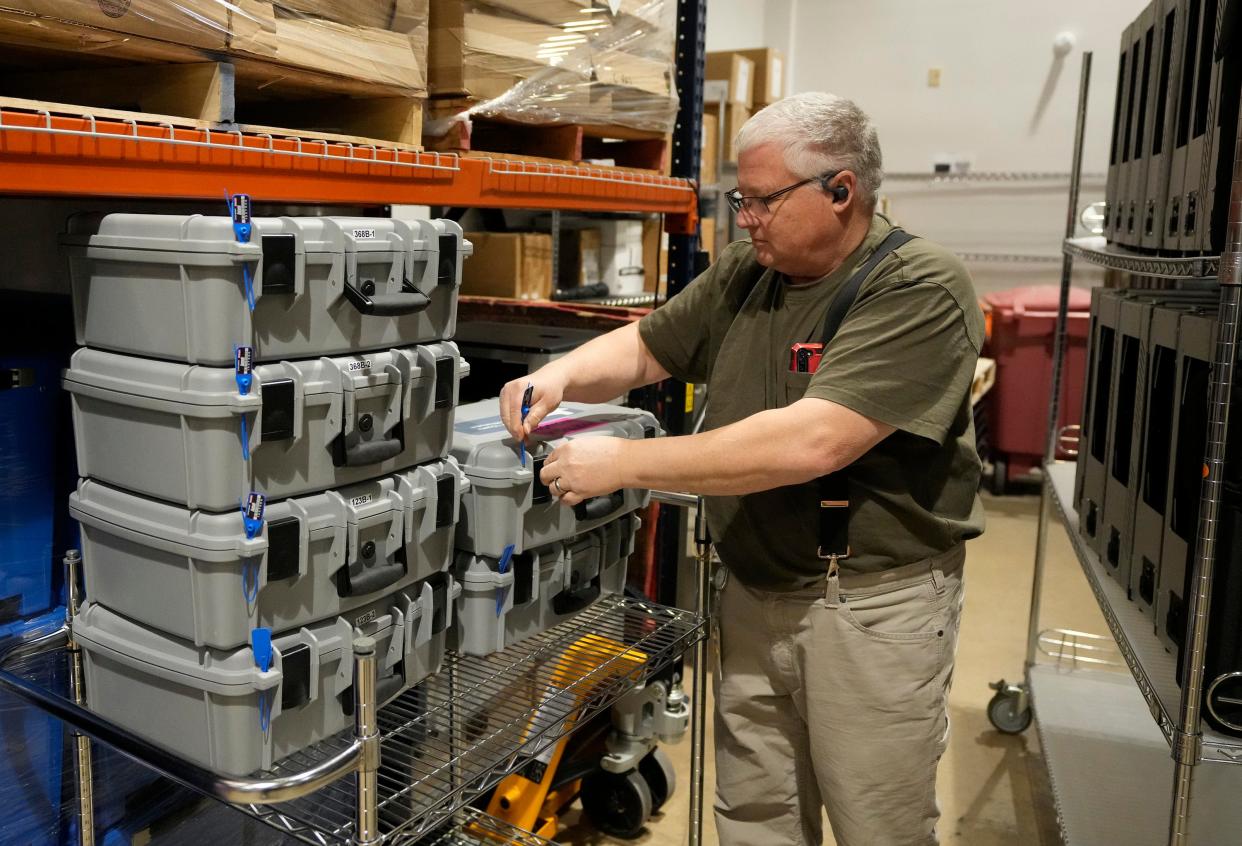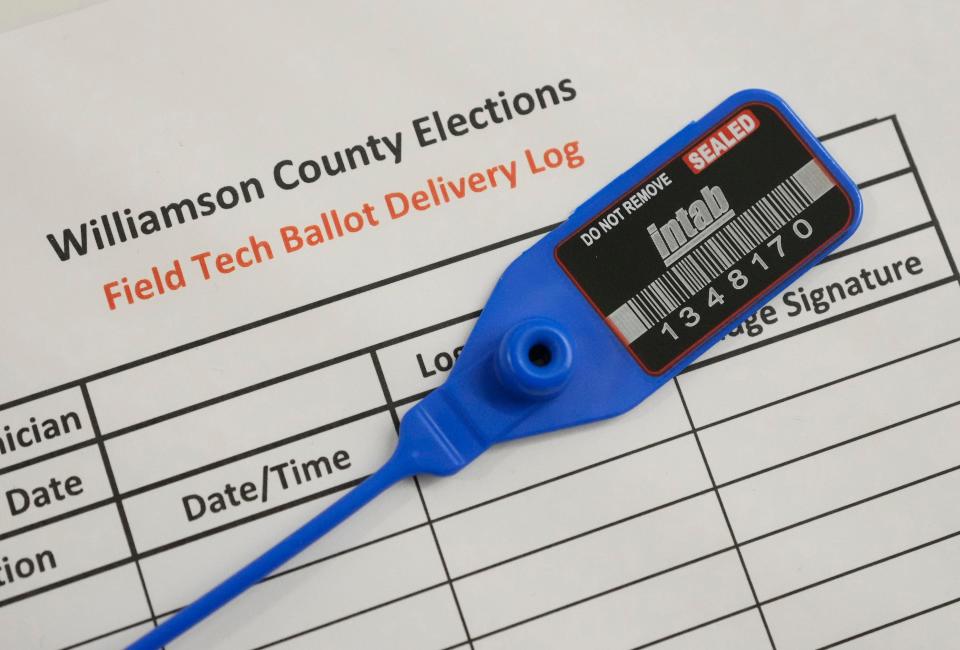Some Texas counties are required to livestream election ballot storage areas. Here's why.

On a recent afternoon in an office in Georgetown, a man with salt-and-pepper hair and a red plaid shirt eats from a Styrofoam bowl placed next to his computer, carefully cupping his hand under the spoon to keep its contents from spilling onto the keyboard. His eyes are locked on the computer in front of him, and between bites, he continues typing.
He’s alone in the room, but any internet user in the world can watch him on a livestream. Video of this room — and four other locations in the Williamson County elections office — has thus far broadcast more than 400 continuous hours of the man and other officials in their day-to-day work.
The county implemented the livestreams to comply with a 2021 Texas law that requires any county with a population of more than 100,000 to conduct video surveillance of “all areas containing voted ballots” after their delivery to central counting, and to make one or more of these videos available to the public via livestream. (Audio is not required.)
The state mandate has added to county election offices' workload and mental load, and to taxpayer costs, Austin-area officials say. It's also caused technical issues, such as when Travis County in 2022 cited its livestreams as the reason behind a website crash.
The law was born out of distrust in elections, especially in a state where high-ranking officials, such as Attorney General Ken Paxton, openly supported former President Donald Trump’s false allegations of 2020 voter fraud.
"People don't understand (working in) elections is not an easy job," Williamson County Elections Administrator Judith Ritchie said. "The hours it takes, the scrutiny we're under. And that's changed in the past several years where elections are very scrutinized in our society."
How the law was passed — and how it went unnoticed
The video surveillance requirement is part of Senate Bill 1, or the Election Integrity Protection Act of 2021, a sweeping 76-page reworking of Texas election practices passed by the Legislature and signed into law by Gov. Greg Abbott.
Introduced by Sen. Bryan Hughes, the law aims to limit “fraudulent practices” in elections. It banned 24-hour and drive-thru voting, added new rules for mail-in voting, expanded access for poll watchers and created new criminal penalties for election-related offenses, among other changes.
The months of partisan disputes that preceded its passage generated significant coverage from both state and national media for its restrictions to voting access. Texas Democrats fought hard against the bill, even leaving the state in a last-ditch attempt to break quorum and defeat the bill.
The uproar over voting access issues seemed to overshadow the video surveillance requirement, which received almost no media coverage and very little publicity from Texas lawmakers when the law passed.
Williamson County's election livestreams
Williamson County has five YouTube livestreams currently running, as well as a sixth that shows election staffrs bringing in secure ballot boxes at night after polls close during early and regular voting.
The first, titled "Tabulation Room," shows the office of voting systems analyst Brandon Jenkins. His role includes aggregating vote counts stored on the encrypted USB drives locked inside of DS-200 and DS-850 tabulators, which record results as voters place paper ballots inside machines at polling locations. No voted paper ballots are stored in the room.
Jenkins did not respond to an American-Statesman request for comment.
Neither the tabulators nor the computers in the room are connected to the internet, just to an internal server, said Ritchie, the elections administrator.
Another camera shows the central counting room, which is the heart of the Williamson County elections office. In more active moments, viewers can see staffers conversing and carrying equipment. On Election Day, it will show the ballot board qualifying and counting early and mail-in ballots, then qualifying and counting regular election ballots after polls close at 7 p.m.
While the tabulation room livestreams weren't attracting major audiences last week, Ritchie said she receives feedback about the livestreams, including multiple questions from voters during the 2022 midterm election.

What the video surveillance requirement means for Texas counties
The law, Section 127.1232 of the Texas Election Code, requires that counties record “all areas containing voted ballots” from the moment the first voted mail-in or in-person ballot is delivered to central counting — typically about 14 days before the start of a general election — until the canvass of precinct election returns, which Williamson County estimated will be completed about a week after Election Day.
For larger counties such as Williamson, which has a population of more than 609,000, that meant installing seven cameras and recording thousands of hours of footage, which it must retain until the end of the year or until “until an election contest filed in the county has been resolved, whichever is later.”
The state did not allocate funding for cameras, installation, maintenance or data storage, which together cost Williamson County taxpayers more than $10,000, according to figures Ritchie provided.
Travis County, which has a population of about 1.3 million, also had to set up video cameras when SB 1 was approved, Victoria Hinojosa, a spokesperson for Travis County Clerk Dyana Limon-Mercado, wrote in an email. The county now has five livestream views of four sites on its website.
But unlike Williamson County, Travis County has not received feedback from voters, Hinojosa said.
Some counties already had video surveillance systems in place before the law went into effect but added livestreams as called for by SB 1. Hays County, which has a population of 240,000, has used cameras to monitor tabulation and storage areas since 2018. However, it didn't implement its livestreams until it became required, Elections Administrator Jennifer Doinoff wrote in an email.
"If it helps voters gain confidence in the election process, then it's worthwhile," Doinoff wrote.
Only 40 Texas counties are required to install the video surveillance system, but the law and the concept of transparency for voters have influenced smaller counties, too.
In Bastrop County, Elections Administrator Kristin Miles said the county chose to implement its own livestream “because of public perception, and because we knew the population was steadily increasing” from around 97,000 in the 2020 census. Costs were low because the YouTube livestreams are free to create and the elections office already had video cameras set up.
“We didn’t want to be in a position where voters thought that was information that we should have been providing and we weren’t,” she said.
Ritchie in Williamson County supports voters' desire for transparency but wants them to understand the work that goes into providing it.
"We have to ensure that we're doing the best that we can to follow the law and to comply," she said. "It's stressful on folks. ... We're exhausted by the end of an election."
A good way for voters to resolve doubts or questions about election security is volunteering and seeing the process firsthand, she said.
"Every voter who's questioning should go out and educate themselves and learn how things work," she said. "Come be a poll worker; come learn how our systems work, how our procedures are done, why we do these procedures. Until you are part of that engine that runs democracy, you will not understand."
This article originally appeared on Austin American-Statesman: Texas elections: Some counties required to livestream ballot process

